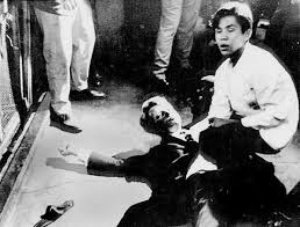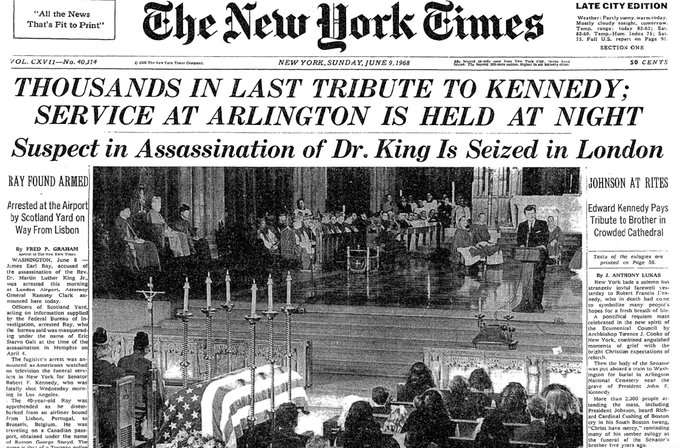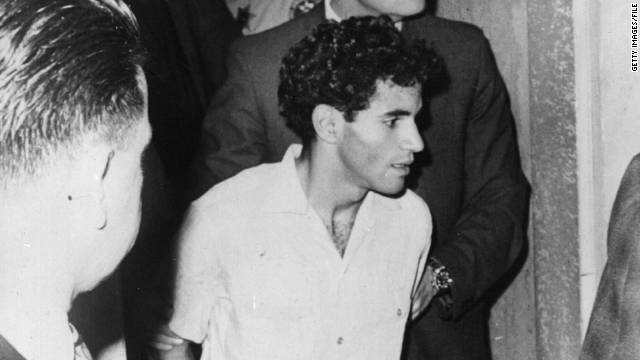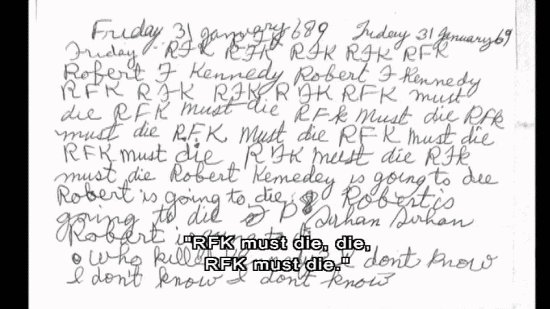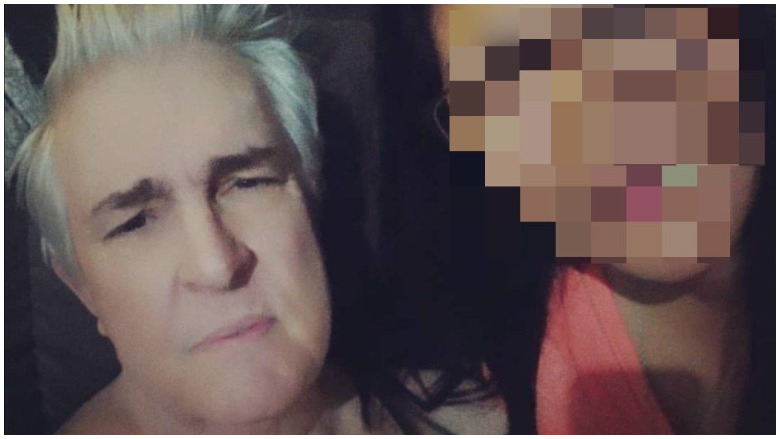
Facebook Thane Eugene Cesar in later years.
Thane Eugene Cesar was the security guard who was standing behind Robert F. Kennedy when the presidential candidate was assassinated in Los Angeles. For years, Cesar, who allegedly disliked the Kennedys, has been the subject of conspiracy theories about RFK’s death, in large part because multiple witnesses saw him draw his gun when Sirhan Sirhan fired toward Kennedy.
RFK’s namesake son, Robert F. Kennedy Jr., wrote on Instagram on September 12, 2019, that Cesar had just died in the Philippines. He wrote that “compelling evidence suggests that Cesar murdered my father.” You can read his Instagram post in full later in this article. In it, RFK Jr. lists, in great detail, the evidence that led him to reach the conclusion that Cesar was involved in his dad’s assassination.
Sirhan Sirhan was convicted of murdering Kennedy. He admitted he murdered the aspiring president, Kennedy brother and former attorney general at his trial, but that was strategic because his lawyers pursued a diminished capacity argument, and he’s also claimed he has no memory of the slaying. As with RFK’s brother, President John F. Kennedy, there are those who argue that the government got it wrong.
For years, the theories that there was another gunman for years have revolved around Thane Cesar, the number of overall shots that were fired, the trajectory of those shots, and whether there might have, thus, been two gunmen. There is no question that Sirhan Sirhan was there, and probably that he opened fire. The question is whether his shot was the one that killed RFK or whether a second gunman fired that bullet.
According to an article in The Washington Post by Tom Jackson, published on May 26, 2018, Bobby Kennedy’s own son, Robert F. Kennedy Jr., came to the belief back then that his father was not killed by Sirhan Sirhan and recently met with him in a California prison. When the meeting was over (which Kennedy did not detail to the Post), “he joined those who believe there was a second gunman, and that it was not Sirhan who killed his father,” the story reported.
“I was disturbed that the wrong person might have been convicted of killing my father,” Kennedy said, joining calls for a new investigation already made by Paul Schrade, who was also shot that day on June 5, 1968 at the Ambassador Hotel in Los Angeles.
For years, Thane Cesar has found himself the target of second gunman theories. Who is Thane Eugene Cesar, who is sometimes called Gene Cesar? “There were dozens of articles that have come out saying that I carried a second gun, and that I possibly could’ve been the person who shot Bobby Kennedy – because the bullet entered the back of his head,” Cesar acknowledged to author Dan Moldea, who has written that he doesn’t believe that Cesar killed Kennedy. Cesar denied firing his gun in an interview with Moldea. The unproven second gunman theories are built on a complex web of ballistics, forensics, and eyewitness evidence.
Heavy reached out to Cesar through his daughter in the Philippines, where he lived. However, she said that he is not granting interviews anymore. That was months before he died. Several days before he died, the daughter, who is from Pasay City, Philippines, wrote the Heavy reporter that she had seen the article but did not respond to further requests for comment.
She has been posting about Cesar’s death on Facebook, and she posted a full-throttled defense of him written by the author Moldea, which you can read in full later in this article. “I will miss you so much. Today, my heart is broken in thousand pieces. ? I love you daddy,” Cesar’s daughter wrote on September 11, 2019.
Here’s what you need to know:
1. RFK Jr. Says Authorities Have Never ‘Seriously Investigated Cesar’s Role in my Father’s Killing’
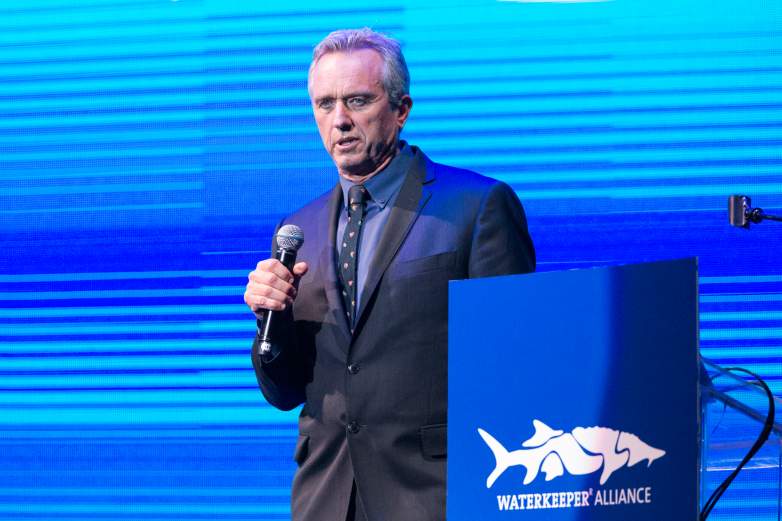
Getty(Getty)
One of the driving forces behind the belief that there was a second gunman is the testimony of famed Los Angeles County Coroner Thomas Noguchi, who maintained from the start that Kennedy was shot from behind and at a closer range than witnesses say Sirhan got to the candidate. Bobby Kennedy told the Post this argument was persuasive to him, saying, “The people that were closest to [Sirhan], the people that disarmed him all said he never got near my father.”
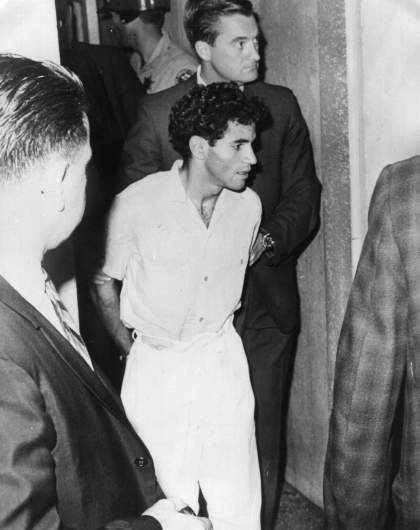
Sirhan Sirhan, charged with the assassination of Senator Robert Kennedy during a campaign stop in California.
In his Instagram post, RFK Jr. wrote that Cesar was “directly behind my dad” when RFK was shot.
Thane Eugene Cesar died today in the Philippines. Compelling evidence suggests that Cesar murdered my father. On June 5, 1968, Cesar, an employee in a classified section of Lockheed’s Burbank facility, was moonlighting as a security guard at the Ambassador Hotel. He had landed the job about one week earlier. Cesar waited in the pantry as my father spoke in the ballroom, then grabbed my father by the elbow and guided him toward Sirhan. With 77 people in the pantry, every eyewitness said Sirhan was always in front on my father at a 3-6 feet distance. Sirhan fired two shots toward my father before he was tackled. From under the dog pile, Sirhan emptied his 8 chamber revolver firing 6 more shots in the opposite direction 5 of them striking bystander and one going wild. By his own account, Cesar was directly behind my dad holding his right elbow with his own gun drawn when my dad fell backwards on top of him. Cesar repeatedly changed his story about exactly when he drew his weapon. According to the Coroner, Dr. Thomas Noguchi, all 4 shots that struck my father were ‘contact’ shots fired from behind my dad with the barrel touching or nearly touching his body. Cesar sold his .22 to a co-worker weeks after the assassination warning him that it had been used in a crime. Cesar lied to police claiming that he’d disposed of the gun months before the assassination. Cesar was a bigot who hated the Kennedys for their advocacy of Civil Rights for blacks. I had plans to meet Thane Eugene Cesar in the Philippines last June until he demanded a payment of $25,000 through his agent Dan Moldea. Ironically, Moldea penned a meticulous and compelling indictment of Cesar in a 1995 book and then suddenly exculpated him by fiat in a bizarre and nonsensical final chapter. Police have never seriously investigated Cesar’s role in my father’s killing.
These are not new arguments, although RFK Jr.’s voice lends a powerful advocate for the theories that there was a second gunman. In 2012, UPI reported that Sirhan’s lawyers “say a second gunman fired the fatal shot.” However, they “ruled out a security guard long suspected of playing a role in the slaying,” UPI reported. The lawyers were trying to get a new trial for Sirhan, and they said in court filings that Cesar was not the killer. However, they wanted an evidentiary hearing.
The Los Angeles Times reported in 2005 of Los Angeles County Coroner Noguchi’s findings: “Eyewitnesses put Sirhan no closer than 18 inches from Kennedy, but Noguchi testified that when the fatal wound was inflicted the gun was 1 inch to 1 1/2 inches from Kennedy’s ear. His testimony fed conspiracy theories that Sirhan had not acted alone.”
Here’s part of a Noguchi radio interview, in which the coroner essentially repeats that point:
“Based solely on the examination of the remains and the scene afterwards, I came to the conclusion that the Senator Bobby Kennedy was shot by a small caliber gun from the right side of the back of the head,” he said during the above interview. Noguchi said the fatal wound came at such close range that it was “perhaps three inches from the back of the ear. Might even be one inch.” He said that he understood that witnesses produced by the prosecution had not been able to find any witness to say that Sirhan was that close. However, he said, “everyone was in a panicky situation.”
Noguchi found other curious details when he studied the body. Noguchi also “found powder burns on the senator’s jacket and on his hair, indicating shots fired at close range,” The Post reported. The Post reported that Schrade believes Sirhan did fire and wound others but did not kill Kennedy.
“According to the autopsy report, the coroner concluded that the senator’s body and clothing were struck from behind, at right rear, by four bullets fired at upward angles and at point-blank range. Yet witnesses said Sirhan fired somewhat downward, almost horizontally, from several feet in front of Kennedy, and witnesses did not report the senator’s back as ever being exposed to Sirhan or his gun,” CNN reported.
That raises the question: If there was a second gunman, who was it? That has never been determined.
2. Thane Cesar Was a Last-Minute Addition to the Security Detail Who Once Allegedly Called the Kennedys a ‘Bunch of Crooks’ But Author Moldea Thinks He Is Being Falsely Accused of Killing Kennedy
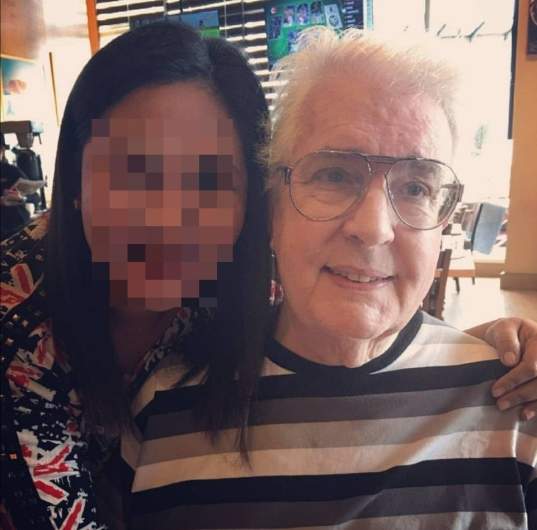
Thane Eugene Cesar
Cesar’s daughter posted a lengthy defense the author Moldea wrote about Cesar, writing on Facebook, “I am the proud daughter of Thane Eugene Cesar. Thank you Dan E. Moldea for this ❤️.”
This is Moldea’s post in full:
12:30 PM. . . . Thane Eugene Cesar—the security guard still falsely accused of killing Senator Robert Kennedy in June 1968—died an hour ago at a Manila hospital in the Philippines after a long illness. He was 77 years old. . . . When I first entered the RFK murder investigation in 1987, I, too, believed that Cesar—who was standing next to Senator Kennedy with a gun in his hand and powder burns on his face—was a possible second gunman. However, I continued to investigate and was able to find and repeatedly interview Gene, whom the Los Angeles District Attorney’s Office, as well as the LAPD, believed to be dead.
After spending over forty hours with him, I wanted some test or measurement to determine how much time and money I needed to continue pursuing him. Marvin Rudnick, a trusted friend who was a former federal prosecutor in LA, suggested that I arrange for Cesar to take a polygraph test. . . . Thus, if he failed, I would never stop coming after him. If he passed, I would treat him as another eyewitness to the killing.
Cesar agreed to take the lie-detector test—personally conducted by Edward Gelb in LA, then the president of the American Polygraph Association. Cesar passed with flying colors and no room for doubt.
In short, Gene Cesar was an innocent man, wrongly accused of murdering one of the greatest crimefighters in American history. And I was proud to proclaim his innocence in my 1995 book about the murder of Senator Kennedy. Four years later, Cesar invited me to be the godfather of his newborn son, and he asked me to handle all media inquiries for him, giving me his legal power of attorney, which I still retain.
Attached is a 1:28-minute excerpt of my twelfth and final recorded interview with Cesar which took place on June 4, 1994, the day before my third and final face-to-face interview with Sirhan Sirhan, whom I concluded in my 1995 book committed the murder and acted alone.
BTW: I am the only person in the world, living or dead, who has interviewed both Cesar and Sirhan.
God bless Gene Cesar, a tragic character in a footnote of American history, who will sadly continue to be defamed long after his death.
Moldea also wrote a comment to Cesar’s daughter on Facebook, saying, “Your dad was an innocent man, wrongly accused. I was proud to exonerate him with overwhelming evidence–although I fully realize that the reckless and malicious charges against him will not stop. . . . Trust me, I will continue to defend him. . . . God bless Gene, Ellie, you, and your family.”
You can watch the post Moldea posted on Facebook here.
An article in The Washington Post recounts the conspiracy theory this way: “Thane Eugene Cesar, a security guard with extreme right-wing views, who hated Kennedy, was standing next to the senator at the moment of the shooting and had a gun in his hand and powder burns on his face.” However, when the article’s author, Dan Moldea, interviewed Cesar, he decided that he was innocent of any involvement, writing that he “arranged for Cesar to be polygraphed. He passed.”
Moldea recounts how Cesar was allegedly a last-minute addition to the Kennedy security detail and didn’t want to go. He described him as 26, and working as a plumber at Lockheed Aircraft. He’d been married to Joyce for five years, and the marriage was troubled, Moldea writes. He worked part-time as a security guard, and his boss, the manager of Ace Guard Service, where he worked, called and asked him to help with security at the Kennedy event.
He was carrying a .38 Rohm revolver (Kennedy was shot by a .22, which Sirhan had. Cesar acknowledged that he also owned a .22 but said he didn’t have it with him that fateful day. However, his comments on that weapon provoked more controversy). At the Ambassador, Thane Cesar reported to “Fred Murphy, the Ace commander and a former LAPD lieutenant, and William Gardner, the hotel’s chief of security,” Moldea writes. “I’m on the right side of him,” Cesar told the author. “And what I’m doing is taking my hand and pushing people back, because Kennedy was having a hard time walking forward.” He saw flashes and reached for his gun, the author wrote in The Killing of Robert F. Kennedy: An Investigation of Motive, Means, and Opportunity.
Cesar told the LAPD that Kennedy was two feet from Sirhan’s gun, the book reports. According to Moldea’s book, several witnesses saw Cesar with the gun in his hand. One said he was “pointing it down in Kennedy’s general direction” and another expressed relief that Cesar had not fired at Sirhan.
Cesar has denied firing his weapon. He was interviewed within minutes of the shooting by John Marshall, a radio reporter, and said, “I was there holding his arm when they shot him” and “As he (Kennedy) walked up, the guy pulled a gun and shot him.” He said he was on Kennedy’s right side. He said he reached for his gun but “it was too late.” Police at the scene did not examine Cesar’s gun.
One curious aspect of the case is what happened to Cesar’s tie during the assassination, as some say it can be seen lying on the ground next to RFK in one of the most iconic shots of the Senator dying on the floor (the photo under this fact).
Online property records show Thane E. Cesar with a P.O. box and address in Simi Valley, California, but there is no record trail since 2009. Defense investigator Bob Kaiser said of the guard, “he was innocent; there was no doubt in my mind.”
Thane Cesar was standing directly behind Kennedy, gave “different versions of his movements” and about when he drew his gun, was a “supporter of 1968 American Independent Party presidential candidate George Wallace and made no secret of his hatred of the politics of both John and Robert Kennedy,” the Moldea book says. However, he also offered to surrender his gun to authorities (although they didn’t take him up on it at the time of the assassination), volunteered that he owned a .22, and agreed to take a polygraph.
The 1987 interview the author conducted occurred when Cesar was 45 and living in Simi Valley. He is English, French, and German in descent and the son of a housewife and air freight dispatcher. He played football in high school and studied police science. He was rejected by the LAPD and became a plumber, the book says. He had two children and was divorced from his first wife. He married a second time in 1969. At one point, he filed for bankruptcy. He was a former Democrat turned Reagan supporter at the time of Moldea’s interview. He said he was raised prejudiced and was “probably prejudiced today.”
He also allegedly called the Kennedy family the “biggest bunch of crooks that ever walked the earth,” the book says. Cesar allegedly added, “I had no use for the Kennedy family.” But he said that didn’t make him guilty. “Just because I don’t like Democrats don’t mean I go around shooting them,” he allegedly told the author. In an interview, though, Cesar “denied every having held extreme right-wing views on racial issues, ever having canvassed for George Wallace, or ever having professed hatred for the Kennedys,” Moldea wrote.
According to the book, Cesar said another Ace Guard said he “wouldn’t be a bit surprised if somebody didn’t try to knock Bobby off.” He was guarding the pantry but didn’t see Sirhan. He said he had “powder burns in his eyes.” The police didn’t seem interested in interviewing him thoroughly or checking his gun.
3. One Witness Said He Saw the Security Guard Fire His Weapon but Others Just Saw Him Holding it
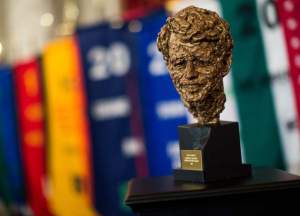
Getty(Getty)
There were many people jammed into the room where Kennedy fell. As a result, there were many eyewitnesses to his death, and, unlike the death of his brother, they had a close view. Multiple witnesses saw Thane Cesar pull out his gun, but only one accused him of firing it, which Cesar has denied over the years.
The key witness cited by many believers of the second gunman theory is a man named Don Schulman, who was then a runner for KNXT-TV.
He gave an interview at the scene to a local television reporter. “Well, I was standing directly behind him. I saw a man pull out a gun. It looked like he pulled it out of his pocket. He shot three times. I saw all three shots hit the senator. Then, I saw the senator fall and was picked up and carried away. I also saw the security men pull out their weapons. After that, it was very fuzzy. The next thing I knew, there were several shots fired. I saw a woman with blood come out of her temple… I saw the security police grab someone… the crowd was very panicky.”
The site RFKProject says Schuman appears in a video at 2:42, confirming he was there that day. The police report on Schulman’s statement doesn’t mention the security guard angle.
Schulman later grew more confident about what he says he saw when speaking to Ted Charach for a controversial documentary Charach made putting forth the second gunman theory. He said he was “following the senator….we were packed in there like sardines….another man stepped out and he shot. Just then the guard who was standing behind Kennedy, he took out his gun, and he fired also.” He said that Sirhan Sirhan was about 3 to 6 feet behind Kennedy, but that the guard was standing on the right hand side, directly and behind Kennedy. He said he told the story to several police authorities. He added, “The guard definitely pulled out his gun and fired.”
Schulman also said, “A Caucasian gentleman stepped out and fired. The security guard hit Kennedy all three times. Kennedy slumped to the floor. The security guard fired back…” One Schulman statement was taken by a reporter named Jeff Brent. He later alleged to Charach, a researcher, “… a guard definitely pulled out his gun and fired… He wasn’t very far from Kennedy.” Again, Schulman’s account is unproven, other witnesses did not allege the same, and Cesar denies firing his gun, which he says was a different caliber from the .22 that took Kennedy’s life.
The Guardian reported in 2006, “Witnesses place Sirhan’s gun several feet in front of Kennedy, but the fatal bullet is fired from one inch behind.”
In 2012, CNN reported on a federal court hearing into Sirhan’s lawyers challenges against his conviction and a witness named Nina Rhodes-Hughes. “What has to come out is that there was another shooter to my right,” Rhodes-Hughes said to CNN. “The truth has got to be told. No more cover-ups.”
At trial, Sirhan testified he murdered Kennedy “with 20 years of malice aforethought,” but later recanted, CNN reported. He received the death penalty but in 1972 this was changed to life in prison. A 2016 appeal in the case was rejected. U.S. Magistrate Judge Andrew Wistrich wrote that Sirhan would be liable “as an aider and abettor” even if someone else killed Kennedy, the Post story reported, adding, that the idea of a second gunmen shooting Kennedy “at close range with the same type of gun and ammunition as [Sirhan] was using, but managed to escape the crowded room without notice of almost any of the roomful of witnesses, lacks any evidentiary support.”
4. Thane Cesar Gave Shifting Stories About His .22 Revolver & Moved Overseas
It’s been alleged that Cesar owned an H&R .22 revolver and sold it later to Jim Yoder, a friend of his in Arkansas. He allegedly told police he sold the .22 before the murder when he actually sold it after the murder. Moldea’s book says that Charach, the documentarian, learned that Cesar sold his .22 revolver to Yoder three months after the assassination, and that Yoder provided a receipt. The book adds that Yoder allegedly told Charach the gun was stolen in a burglary.
In 1971, Cesar was interviewed by the LAPD on the .22. According to Moldea, Cesar denied he owned the gun on the night Kennedy was assassinated and instead said he sold it to Yoder before Kennedy was murdered. Moldea notes that Cesar had sold the gun to Yoder after the assassination and had shown it to a sergeant on June 24, 1968. “But law enforcement authorities accepted Cesar’s account,” he wrote.
Cesar filed for bankruptcy in 1994. He filed an unsuccessful Employment Discrimination suit against Anheuser Busch “and subsequently moved to the Philippines. It doesn’t sound like the profile of an assassin on a CIA pension,” wrote author Shane O’Sullivan in the book Who Killed Bobby? The Unsolved Murder of Robert F. Kennedy.
However, some people believe questions still remain.
“It’s clear that Cesar’s position behind and to the right of Kennedy matched the shooting position described in the autopsy,” the book reports. He had advance notice Kennedy was coming through and was “possibly seen talking to Sirhan.” He “has repeatedly changed his story on when he drew his gun, and his movements after the shooting…Questions remain as to who pulled his tie off.”
Cesar “told the LAPD that he ducked and was knocked down at the first shot,” according to The Assassinations: Probe Magazine on JFK, MLK, RFK, and Malcolm X.
Eara Marchman told the LAPD that she saw a man arguing with a “uniformed guard who was standing by swinging kitchen door,” The Probe Magazine book asserts. Cesar denied seeing Sirhan before the shooting. Cesar “was only hired in May of 1968, just days before the assassination,” the book says.
5. Some Witnesses Heard More Than Eight Gunshots but Sirhan’s Gun Didn’t Hold More
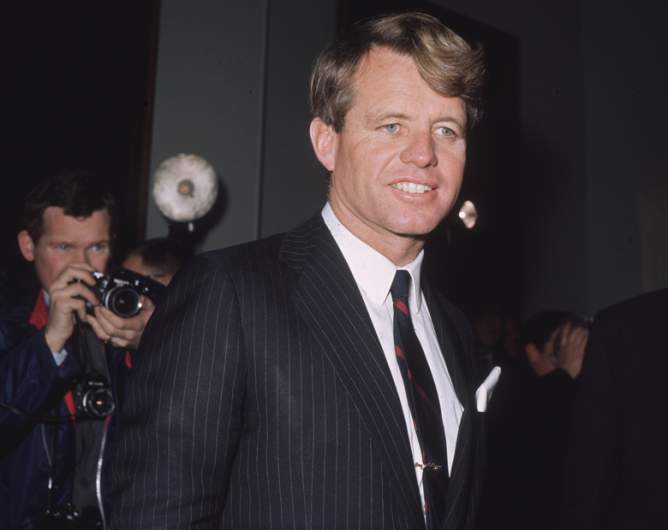
Robert Kennedy
Another key argument of those who believe the second gunman theory is that Sirhan Sirhan was carrying a .22 that only held eight bullets and didn’t reload, but some witnesses (and audio experts) allege that more than eight shots rang out. Rhodes-Hughes told CNN she heard more than eight shots. “There were too many bullets,” Robert Kennedy Jr. said to The Post in 2018. “You can’t fire 13 shots out of an eight-shot gun.”
CNN reported that at least four other witnesses told authorities they may have heard more than eight shots. They are Jesse Unruh, Frank Mankiewicz, Estelyn Duffy LaHive, and Booker Griffin. Furthermore, there is an audio recording of the assassination that was captured by a freelance journalist named Stanislaw Pruszynski. Some experts say the audio recording captured the sound of 13 shots.
An acoustic expert named Philip van Praag examined the audio, which the Polish journalist did not realize he was recording at the time. “…there are two pairs of double shots that occurred so close together it is inconceivable that Sirhan could have fired them all. The third and fourth shots and the seventh and eighth were separated by 122 and 149 milliseconds respectively,” Spartacus Educational alleges.
“One witness said that those shots came so close together that he could scarcely believe they were fired from one gun,” and another witness said the shots sounded like they came from a machine gun, legendary news anchor Walter Conkrite said in one of the news broadcasts from the time.
According to CNN, “The Los Angeles County coroner determined that three bullets struck Kennedy’s body and a fourth passed harmlessly through his clothing.”
The Post noted that a ballistics expert testified at trial that a bullet in Kennedy’s body matched Sirhan’s gun, but other experts found that bullets at the scene were from different guns. Some also argue that possible bullet holes in door frames show there had to be a second gunman.
In 2008, The San Francisco Chronicle ran an article on the Robert Kennedy assassination. Of Sirhan, it reports that he was “Palestinian who was raised in the Middle East until he was 12, when his family settled in Southern California.” He “held a series of menial jobs” and once wanted to be a jockey, the newspaper reported.
There is certainly a lot of evidence that Sirhan Sirhan murdered Kennedy, not to mention the fact that he was captured at the scene and seen firing at Kennedy by multiple witnesses. He also wrote about killing RFK in journals.
He wrote “RFK must die” in his diary and authorities thought that the date of the assassination tied into the “one year anniversary of the Six-Day War,” the article says.
Among anolamlies in the case, the Chronicle cited the fact that Noguchi “reported that the fatal shot was fired less than one inch from Kennedy’s head behind his right ear.” Four shots came from the rear but Sirhan fired a .22 “from a few feet in front of Kennedy.” The revolver held eight rounds, but “a radio reporter’s tape recording of the shooting has sounds of what one audio expert describes as 13 shots” and “double shots,” reported The Chronicle, summing up the main concerns.

